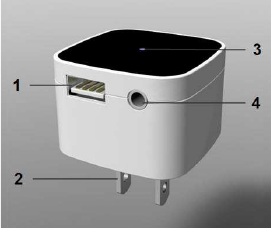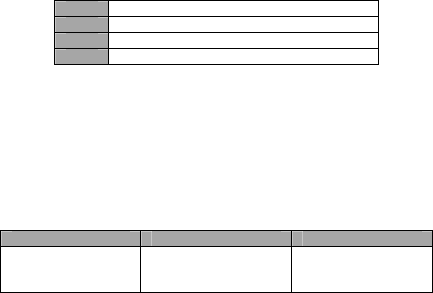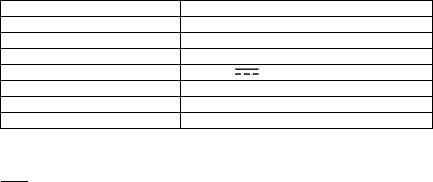Scosche BTRH Bluetooth Audio Receiver User Manual BTRH User s manual of updated 121128
Scosche Industries Inc Bluetooth Audio Receiver BTRH User s manual of updated 121128
Scosche >
Manual
BTRH
Bluetooth audio receiver
User’s manual
Content
Brief introduction
…………………………………………….…....….1
1. Bluetooth wireless communication technology………….……………1
2. About BTRH………………………………………………………..…1
Basic operation
………………………………………………….....…..1
1.
Overview
…………………………………………………...…...………1
2. The steps of operation………………….…………………….…………2
3. Paired with Bluetooth device……………………………………...……2
1) How to enter paired mode…………………………………………...….2
2) Pairing with Bluetooth phone……………………………………….….2
3) Pairing with Bluetooth transmitter………………………………..…...3
4. Supply power for other device charging………………………………3
5. LED indicator…………………………………………………………...4
Care and maintenance
……………………………..………..………4
FAQs
……………………………………………………..…………..….5
Specifications
………………………………………………………….5

Welcome to use this Bluetooth audio receiver BTRH. Please read this user’s
manual carefully before use.
Brief introduction
1. Bluetooth wireless communication technology
Bluetooth is a standard of close range wireless communication technology
that was drawn up by Ericsson, IBM, Intel, Nokia and Toshiba in May, 1998.
With Bluetooth technology, we can achieve the highest transmission rate
among cell phones, computers, printers, PDAs and other devices. The max
transmission range of class II is 10 meters while the max transmission
ranges of class I can reach up to 100 meters.
2. About BTRH
BTRH is a stereo Bluetooth receiver with power pin, it has following
features:
Enjoy stereo music wireless with device which support Bluetooth A2DP
profile;
It can supply DC5V-1A to other device for charging.
Basic operation
1.
Overview
1

1 USB charging jack
2 Power pin
3 Status indicator light
4 3.5mm audio line-out jack
2. The steps of operation
The receiver will turned on automatically when plug it into standard AC
socket, and it will enter pairing mode
Paired with Bluetooth phone or Bluetooth transmitter
Connected receiver and external audio device through 3.5 to 3.5mm
audio line
It can transfer music from phone or transmitter to external audio device
3. Paired with Bluetooth device
1) How to enter pairing mode
Function Operation LED indicator
Entering pairing
mode After turned on, it will
enter pairing mode
automatically
Blue LED flash
continuously
Remarks:
The pairing mode will last 2 minutes, BTRH will switch to standby mode
automatically, if no devices can be connected after 2 minutes
2) Pairing with Bluetooth phone
Prior to using the receiver for the first time, you have to pair it with a
Bluetooth phone. Please make sure your phone has Bluetooth function and it
is available. The pairing procedures are subject to different models of cell
phones. Please refer to your cell phone user’s manual for further information.
The general pairing procedures are as follows:
Keep your receiver and phone within 1 meter when pairing;
Make the receiver enter pairing mode(please refer to “How to enter
pairing mode”)
Activate your cell phone’s Bluetooth function and set your cell phone to
search for Bluetooth devices within range, and select “BTRH” from the
list of devices shown;
According to the indication, enter password or PIN No: “0000”, and
press “YES” or “Confirm”;
2

If prompted by your cell phone to connect, select “Yes” (this will vary
among cell phone models). After successful connecting, blue LED will
flash twice every 4 seconds.
Remarks:
The receiver can remember 8 paired devices. When the number of
devices exceeds 8, the first one will be replaced.
If the phone and receiver over range, the receiver will disconnect and
enter standby mode. It will connect automatically if phone and receiver
back to available range in 5 minutes. You also can select BTRH on the
phone after 5 minutes.
3) Pairing with Bluetooth transmitter
You can pair receiver with Bluetooth transmitter to enjoy wirelessly music.
Hereby take BTT001 (Bluetooth transmitter for iPod, not included) for
example. The pairing steps are as follows:
Keep the Bluetooth transmitter and the receiver within 1 meter when
pairing;
Make the receiver enter pairing mode (please refer to “How to enter
pairing mode);
Plug the Bluetooth transmitter into cell phone and activate it. The
transmitter will search device automatically and start pairing;
When the receiver requests PIN No., the Bluetooth transmitter will
respond “0000” automatically;
After successful pairing and connecting, blue LED of the receiver blinks
twice every 4 seconds.
Note:
The pairing password of the receiver is “0000”. So, the receiver can only
pair with a Bluetooth transmitter whose pairing password is “0000”.
If pairing still fails after several tries, please refer to the Bluetooth
transmitter’s user’s manual for further information.
4. Supply power for other device charging
The USB port of receiver can provide DC5V-1A for other device charging.
You also can charge your device by BTRH through USB cable.
3

Remarks:
Please use standard USB cable which compatible with your device
The USB port can only provide DC5V-1A, please make sure the charging
voltage of your device is DC5V and the max charging current no higher
than 1A
5. LED indicator
Status of receiver LED indicator
Pairing mode Blue LED flash continuously
Standby mode(not connect device) Blue LED flash once every 2
seconds
Standby mode(has already connected
device) Blue LED flash twice every
four seconds
Care and maintenance
Read the following recommendations carefully before using BTRH.
Following these you will be able to enjoy this product for many years.
Keep it dry and don’t put it in moist place to avoid the product’s internal
circuit being affected.
Keep the product away from direct sunlight or hot places. High
temperatures will shorten the life of electronic devices, destroy the
battery or distort certain plastic parts.
Don’t expose the product to cold areas. It may damage the internal circuit
board.
Don’t try to disassemble the product as it may get damaged if you are not
professional.
Don’t let it fall down onto the floor or other hard surfaces. The internal
circuit might get damaged.
Don’t use intensive chemical products or detergent to clean the product.
Don’t scratch the surface with sharp things.
In case the product doesn’t function properly, send it to the store you bought
it. The staff will help you to solve the problem
4

FAQs
1. Why the receiver can not paired with phone?
Please make sure the receiver is in pairing mode.
The pairing mode will last 2 minutes, it will enter standby mode
automatically if overtime.
Disconnect the receiver and socket, and reconnect them, after the receiver
turned on, it will enter pairing mode automatically.
2. Why it can not connect with phone automatically after over range
and come back?
If it over range, you should come back in 5 minutes, and them the receiver
will connect with phone automatically. If over 5 minutes, you can connect it
by operate your phone.
Specifications
Bluetooth version Bluetooth V2.1+EDR
Bluetooth profiles A2DP
Operating distance Up to 10meters
Power supply demand AC100~240V
USB output DC 5V 1A MAX
Dimension 38.5*38.5*67.5mm
Weight About 43.8g
ambient temperature 40℃ MAX
Notes:
FCC
This equipment has been tested and found to comply with the limits for a
Class B digital device, pursuant to Part 15 of the FCC Rules. These limits
are designed to provide reasonable protection against harmful interference in
a residential installation. This equipment generates uses and can radiate
radio frequency energy and, if not installed and used in accordance with the
instructions, may cause harmful interference to radio communications.
However, there is no guarantee that interference will not occur in a
particular installation. If this equipment does cause harmful interference to
radio or television reception, which can be determined by turning the
equipment off and on, the user is encouraged to try to correct the
interference by one of the following measures:
- Reorient or relocate the receiving antenna.
- Increase the separation between the equipment and receiver.
- Connect the equipment into an outlet on a circuit different from that
to which the receiver is connected.
- Consult the dealer or an experienced radio/TV technician for help.
This device complies with Part 15 of the FCC Rules. Operation is subject to
the following two conditions: (1) This device may not cause harmful
interference, and (2) this device must accept any interference received,
including interference that may cause undesired operation.
Any changes or modifications not expressly approved by the party
responsible for compliance could void the user's authority to operate this
equipment.
INDUSTRY CANADA
This device complies with Industry Canada licence-exempt RSS standard(s).
Operation is subject to the following two conditions: (1) this device may not
cause interference, and (2) this device must accept any interference,
including interference that may cause undesired operation of the device.
Under Industry Canada regulations, this radio transmitter may only operate
using an antenna of a type and maximum (or lesser) gain approved for the
transmitter by Industry Canada. To reduce potential radio interference to
other users, the antenna type and its gain should be so chosen that the
equivalent isotropically radiated power (e.i.r.p.) is not more than that
necessary for successful communication.
Conformément à la réglementation d'Industrie Canada, le présent émetteur
radio peut fonctionner avec une antenne d'un type et d'un gain maximal (ou
inférieur) approuvé pour l'émetteur par Industrie Canada. Dans le but de
réduire les risques de brouillage radioélectrique à l'intention des autres
utilisateurs, il faut choisir le type d'antenne et son gain de sorte que la
puissance isotrope rayonnée équivalente (p.i.r.e.) ne dépasse pas l'intensité
nécessaire à l'établissement d'une communication satisfaisante.
Le présent appareil est conforme aux CNR d'Industrie Canada applicables
aux appareils radio exempts de licence. L'exploitation est autorisée aux deux
conditions suivantes : (1) l'appareil ne doit pas produire de brouillage, et (2)
l'utilisateur de l'appareil doit accepter tout brouillage radioélectrique subi,
même si le brouillage est susceptible d'en compromettre le fonctionnement.